Rhinoplasty is one of the famous plastic surgeries performed in South Korea. Commonly known as a Nose Job, it is a procedure that changes the shape of the nose internally and externally. It involves intricate incisions on the nose to achieve a more natural form that suits and balances the patient’s facial features. There are different types of rhinoplasty procedures catering to various nose issues. For example, there are methods for a crooked nose, humped nose, bulbous nose, and curved nose. All these entail different and unique methods and techniques to obtain a nose that harmonizes with the patient’s overall appearance.

At Answer Plastic Surgery, we use the Golden Ratio of Rhinoplasty as a guide to design the ideal nose that best suits your face. Through accurate measurements and our 3D Virtual Simulation, Dr. Choi provides a before-and-after image during the consultation to give you a better understanding of the procedure and an overview of the surgery. Dr. Choi will extensively analyze your condition in a systematic way where successful results are achieved. With Answer’s Rhinoplasty, you will experience fewer side effects and quick recovery as we are trained to successfully bring results to your satisfaction.
What is Rhinoplasty?
The nose takes up one-third of one’s face and tends to determine one’s overall appearance. Hence, why Korean Rhinoplasty is a popular cosmetic procedure among many individuals experiencing nose shape or size imbalance. Rhinoplasty or Nose Job in South Korea generally involves incisions that can change the nose’s profile and the angle of how it appears in the face. A standard measurement is often used to determine an individual’s ideal nose shape. This is called the Golden Ratio. According to this guideline, the ideal nose measurements depend on the angle between one’s nose bridge and forehead, nose tip, and upper lip. The ideal height from the forehead to the nose bridge measures at a 115° ~ 130° angle. And between the nose tip and the upper lip, the ideal angle is at 95° ~ 100°.

Rhinoplasty is for both men and women; however, it is essential to understand that each individual has different nose shapes. And as every person’s face has a different anatomical structure, a perfect balanced nose shape for others may not be the ideal nose shape for you. Thus, it is essential for you to undergo an in-depth consultation with a specialist like Dr. Choi, who can make precise, calculated measurements to achieve a more proportionate and natural look.
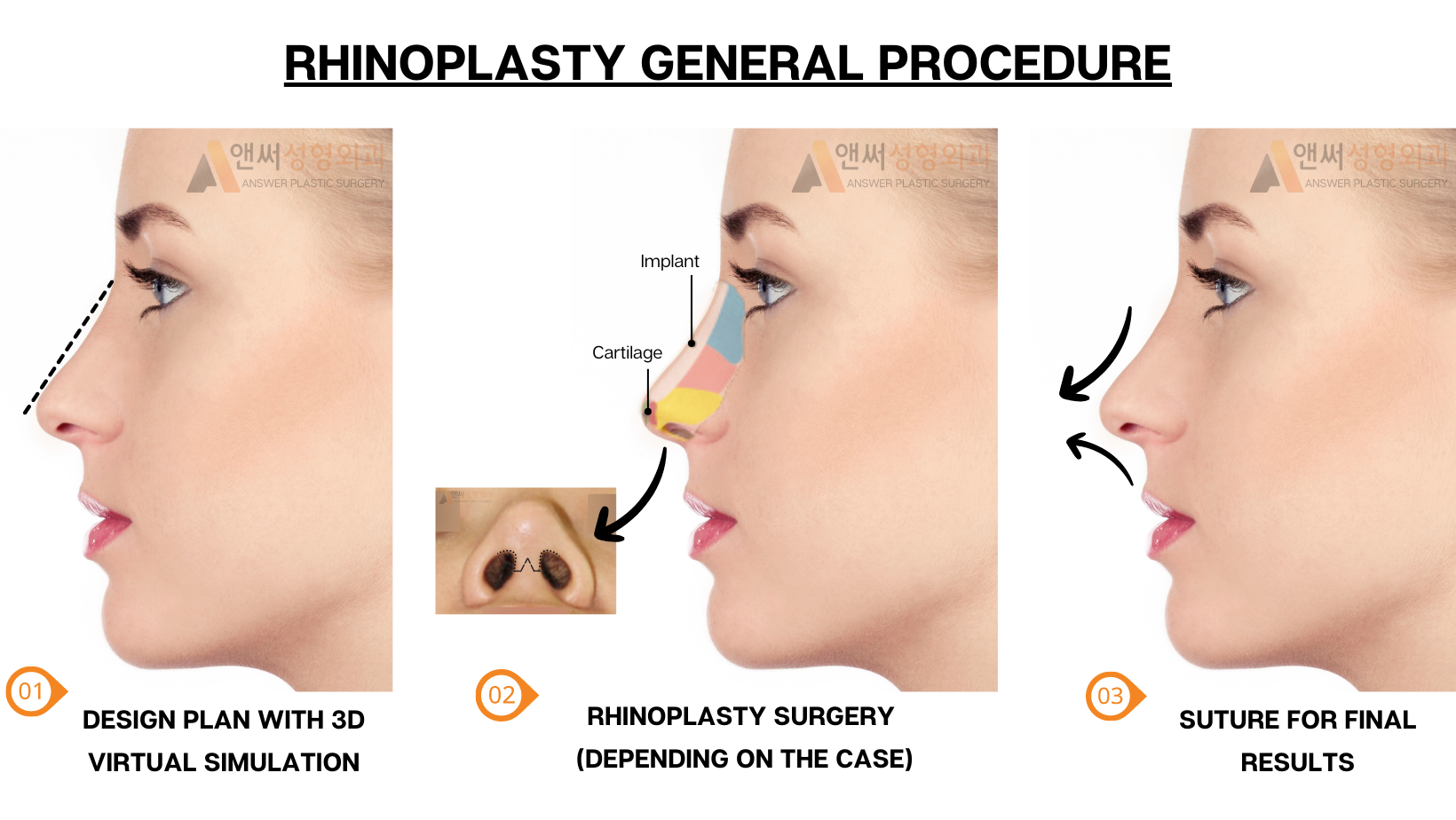
Each Rhinoplasty method is focused on correcting a particular type of nose shape. When the tip of the nose needs improvement, a nasal tip plasty is performed to solve minor external issues of the nose. Implants or prostheses are sometimes utilized to attain the desired shape and look of the nose that best fits the individual’s facial features. Dr. Choi will recommend what implants or prostheses to use according to the customized treatment plan provided during the consultation. The most widely used prostheses are autologous cartilages from the individual’s ear, septum, or rib cage. Depending on the nose’s condition, for example, when the nose’s height needs lifting, Dr. Choi will use a silicon implant to improve the nose bridge’s look. Although sometimes, you may only need non-invasive procedures to achieve your desired nose shape, for example, through a Non-Incisional Rhinoplasty. At Answer Plastic Surgery, Dr. Choi will consider your preference and, from there, recommend what is best for you.
Closed Vs. Open Rhinoplasty

Since there are different types of rhinoplasty, they can be categorized into two methods depending on how the plastic surgeon will address the issue to alter one’s nasal shape. These methods are Closed and Open Rhinoplasty. In South Korea, most plastic surgeons rarely perform Closed Rhinoplasty because of its multiple limitations and the higher risks it presents such as its very narrow surgical area. Instead of closed rhinoplasty, a non-incisional technique is utilized.
Meanwhile, an Open Rhinoplasty allows the plastic surgeon better access to the underlying nasal structures because an incision is made externally between the nostrils at the base of one’s nose.

Each Rhinoplasty method is focused on correcting a particular type of nose shape. When the tip of the nose needs improvement, a nasal tip plasty is performed to solve minor external issues of the nose. Implants or prostheses are sometimes utilized to attain the desired shape and look of the nose that best fits the individual’s facial features. Dr. Choi will recommend what implants or prostheses to use according to the customized treatment plan provided during the consultation. The most widely used prostheses are autologous cartilages from the individual’s ear, septum, or rib cage. Depending on the nose’s condition, for example, when the nose’s height needs lifting, Dr. Choi will use a silicon implant to improve the nose bridge’s look. Although sometimes, you may only need non-invasive procedures to achieve your desired nose shape, for example, through a Non-Incisional Rhinoplasty. At Answer Plastic Surgery, Dr. Choi will consider your preference and, from there, recommend what is best for you.
Features of Answer’s Rhinoplasty
Answer Plastic Surgery invests in advanced diagnostic equipment to bring more precise and accurate measurements to aid in developing a personalized plan for the patient and guide the plastic surgeon during the operation. At Answer Plastic Surgery Clinic, a 3D Virtual Simulation is used to view your pre-surgery appearance and what it would look like after the procedure. This helps you understand the surgery better and can be a deciding factor if you do want to undergo Rhinoplasty. Here, at Answer Plastic Surgery, we also used personalized (autologous) cartilages and authentic, durable implants in combination with more advanced rhinoplasty techniques.
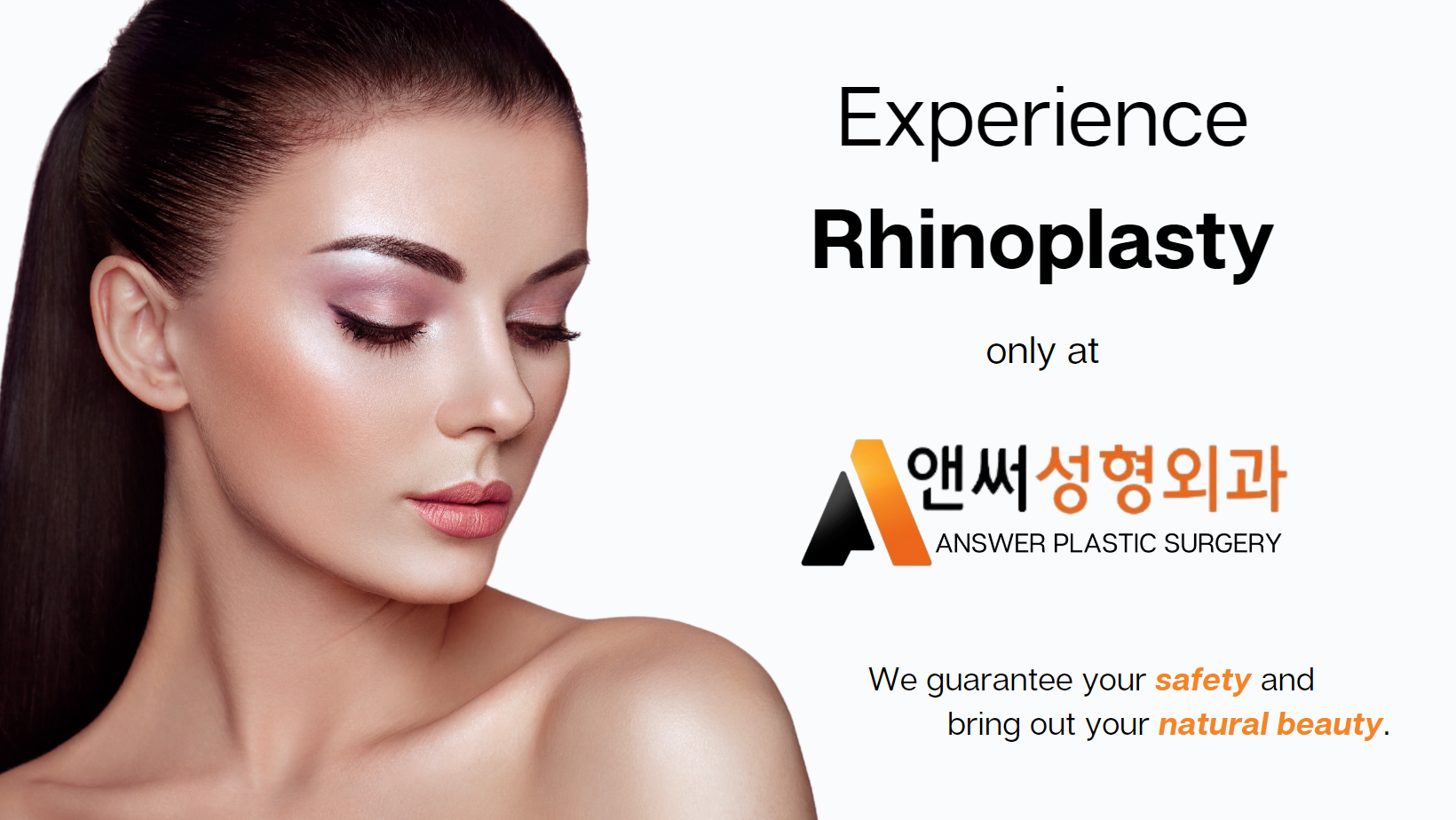
1. Customized Implants and Cartilage
A unique feature offered by Answer Plastic Surgery to our patients is the personalized cartilage and implants used for rhinoplasty. We offer various choices of implants and cartilage and optimize our options depending on the condition of the patient’s nose. We carefully assess if our patients need a combination of different prostheses or if one type of prosthesis is enough to obtain natural outcomes. We also consider the nose’s aesthetic and functional aspects before recommending what is best for the patient.
2. Precise Surgical Incisions Made with Micro-Surgical Instruments
Dr. Choi expertly minimizes the appearance of scars after surgery by utilizing micro-surgical instruments that can hold suture threads precisely and make it easier to perform delicate suturing in such a narrow area. This device is used for externally exposed scars, tissue transplantation, and suturing inside the nose to achieve the best results. As a result, scars become almost invisible with time.
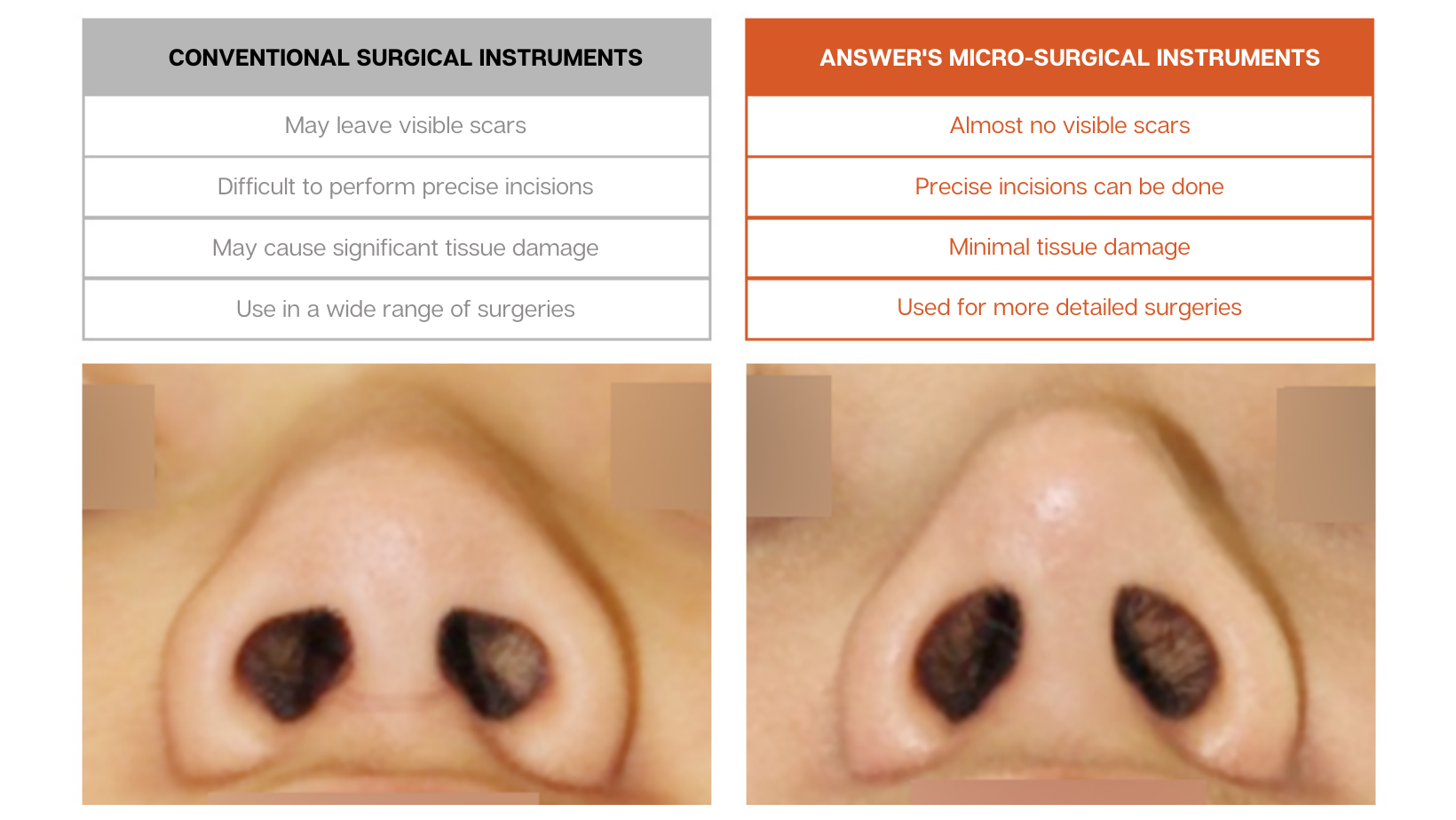
3. A Pre-Surgery 3D Visualization of the Nose
Answer Plastic Surgery also offers our patients a three-dimensional simulation of how they would look after undergoing rhinoplasty with us. We can create a more sophisticated treatment plan to provide highly satisfactory results through this.
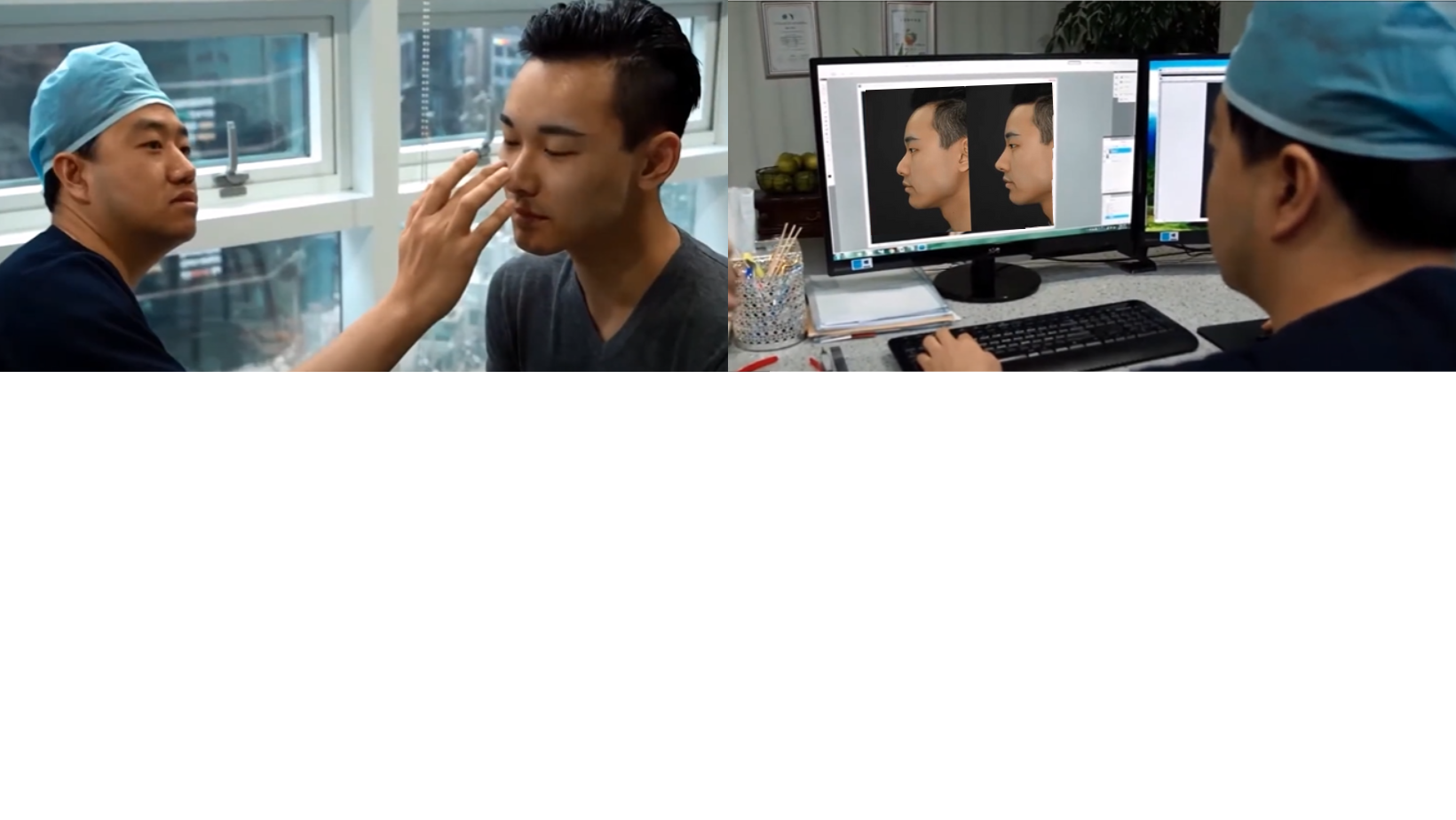
4. A Harmonized and Proportional Overall Appearance
Answer Plastic Surgery prioritizes our patients’ preferences and recommends the best methods to help them achieve their aesthetic goals. It helps when our patients come with realistic expectations to aid us in achieving better outcomes. We ensure that your nose balances your overall facial features, making you look more natural and attractive.
Types of Implants and Cartilages
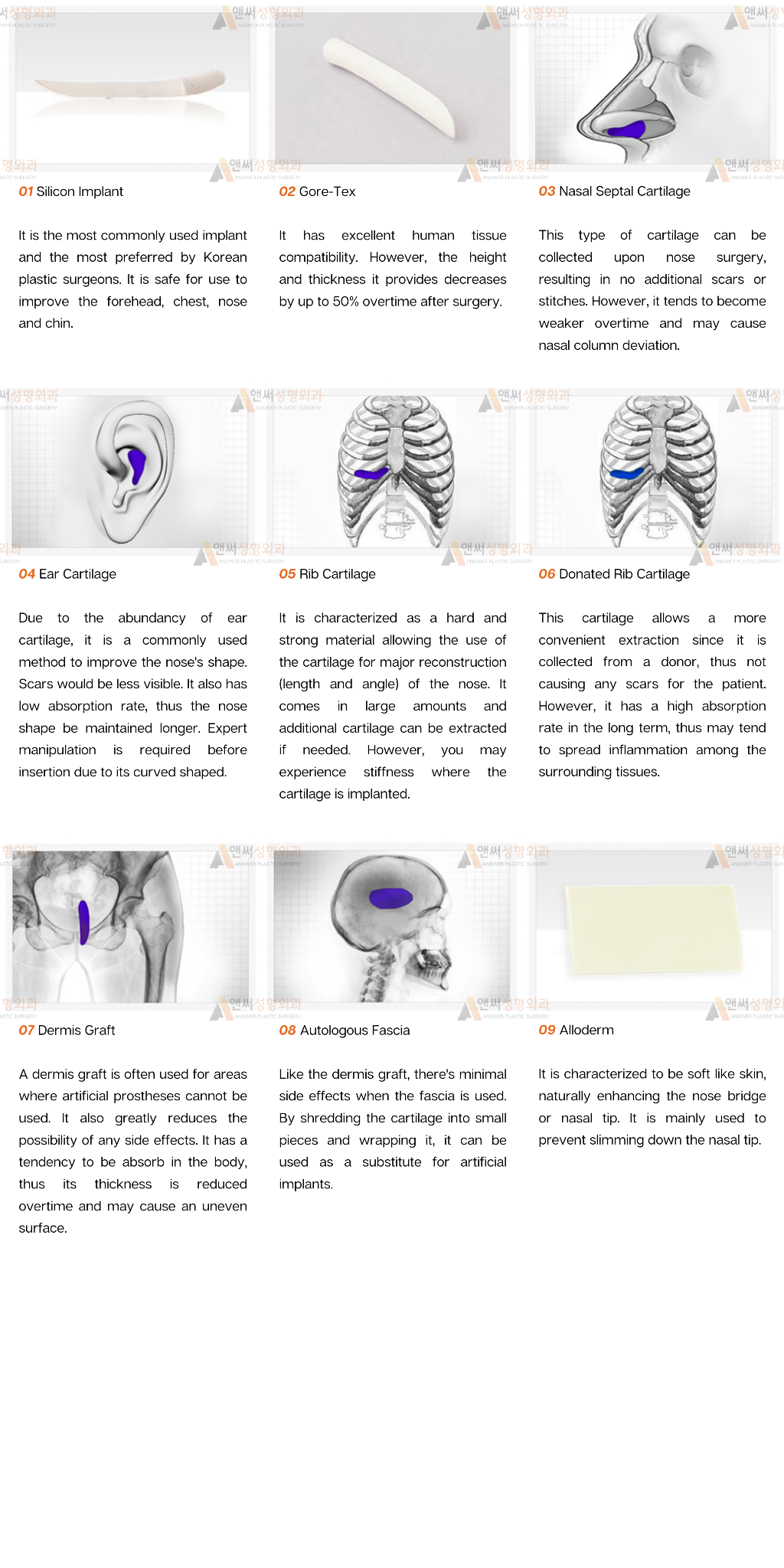
Answer’s Rhinoplasty Techniques Using Different Types of Cartilage
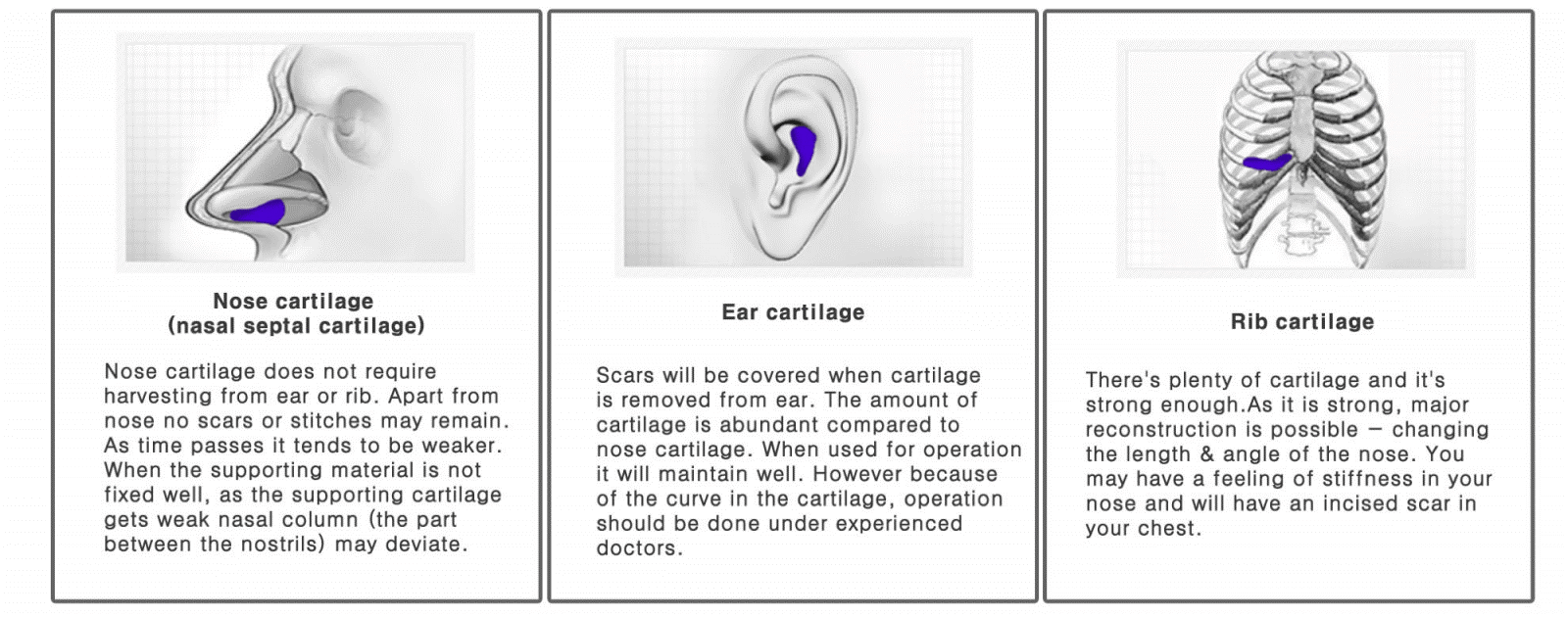
Ear Cartilage
It is advantageous to use ear cartilage for rhinoplasty since it can be harvested on either side of the ears. It is very abundant and has a less absorption rate when transplanted into the nose for surgery. Especially when performing nasal tip plasty, ear cartilage is the best candidate as it creates a natural nose tip due to its unique round and curved shape. It requires a high degree of expertise as the results may vary, depending on how it is used during rhinoplasty. For example, when the ear cartilage is used to build up the nose tip and is not strong enough to support it in the long run, there is a tendency that the nasal tip may droop, ruining the shape.
Answer Plastic Surgery uses a method where the ear cartilage is firmly applied to the nasal tip to form a durable support, preventing the nasal tip from “dropping” after surgery. Here are the results performed at the Answer Plastic Surgery Clinic in South Korea, where ear cartilage is used.
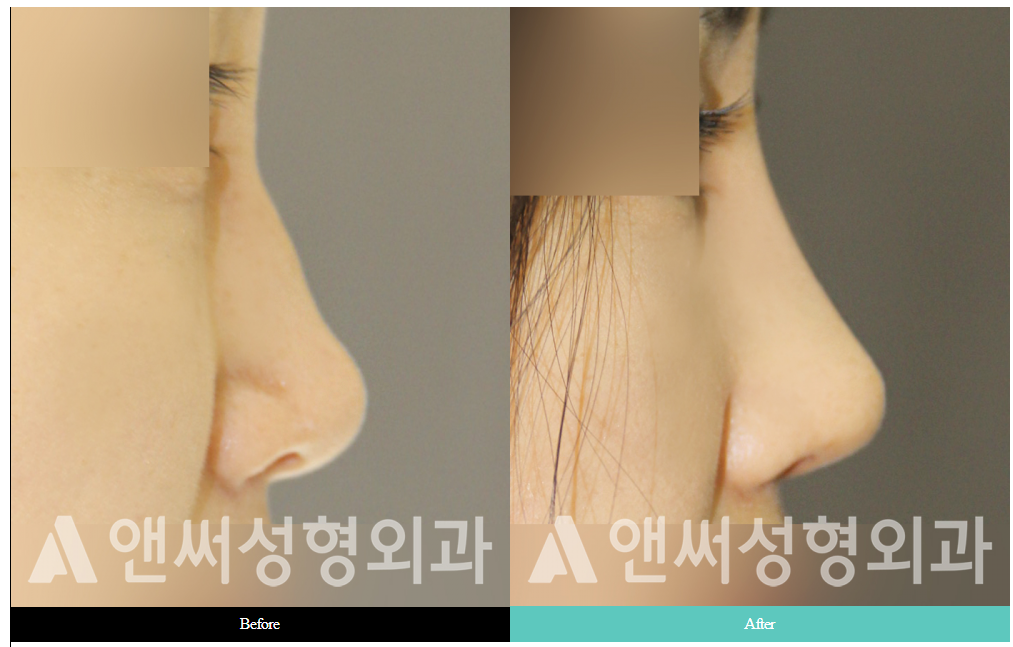
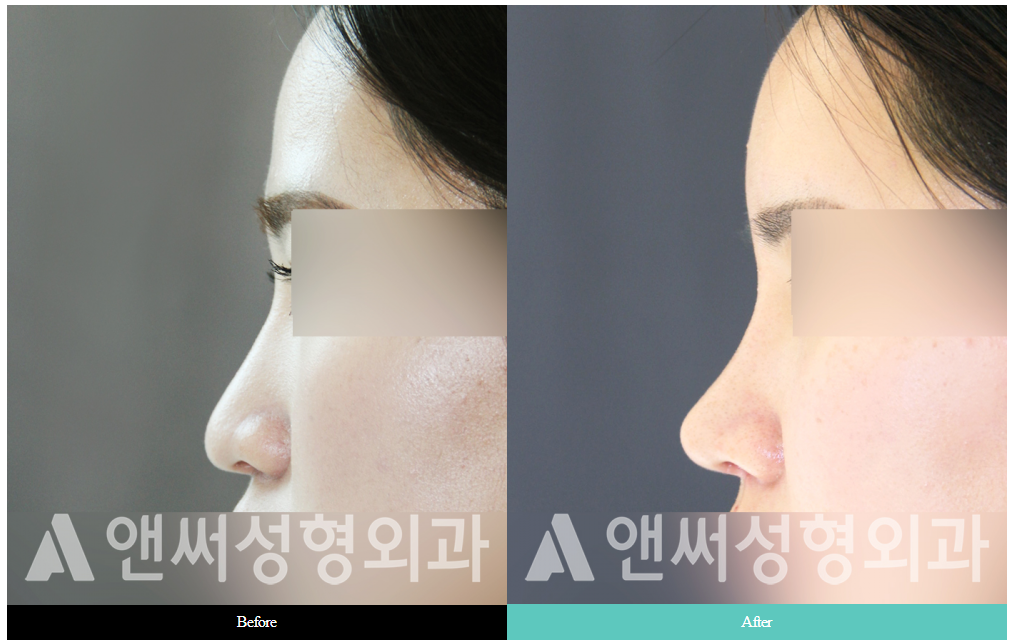
Nasal Septum Cartilage
A significant advantage of the nasal septal cartilage is that it can be collected during nose surgery, and there is no need to additionally collect or harvest more cartilage. When collected, it comes in the form of a broad, flat shaped-plate, thus can be used as a support or added to the nose to extend its length. It is a relatively simple operation since it has been done countless times, and is backed by successful research and case studies. Due to its flat surface, it has a higher chance of dropping than other cartilage types. However, Answer Plastic Surgery ensures that the nasal septum cartilage is appropriately used with the proper techniques to form a durable support for the nose, improving its shape and enhancing its appearance on the face.
Usually, nasal septum and ear cartilage are often used together to achieve more optimal results. But, with a nasal tip plasty procedure, it will not need a lot of cartilage transplantation, so it is possible to use nasal septum cartilage alone during rhinoplasty. Using a combination of cartilage will also depend on the nasal condition of the patient upon assessment.
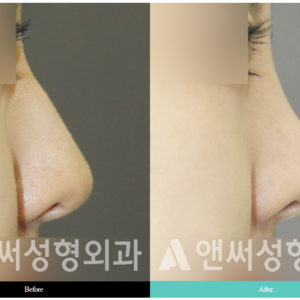
Rib Cartilage
The rib costal cartilage is considered the most abundant and most robust among the three other types. Answer Plastic Surgery can expertly collect this cartilage safely and quickly using advanced techniques. Small costal cartilage can be harvested with a 1 ~ 2cm incision, while large and long costal cartilage can be collected with an incision measuring 2 ~ 3cm.
Sometimes, donated rib cartilage is used so as not to obtain one’s own cartilage. But due to its high absorption rate, it can cause the nasal tip to look more detached over time. This is why it is highly recommended that autologous cartilage is used because it works better and decreases the chance of infection and foreign body reaction. The rib cartilage has a characteristic where it bends over time from the collection to when it is used. Hence, at Answer Plastic Surgery, we ensure that the rib costal cartilage is carefully collected to prevent unnecessary bending to make it usable and durable during our rhinoplasty procedures. The following images are Before and After transformations of patients in Answer Plastic Surgery Clinic that had undergone rhinoplasty using rib cartilage.

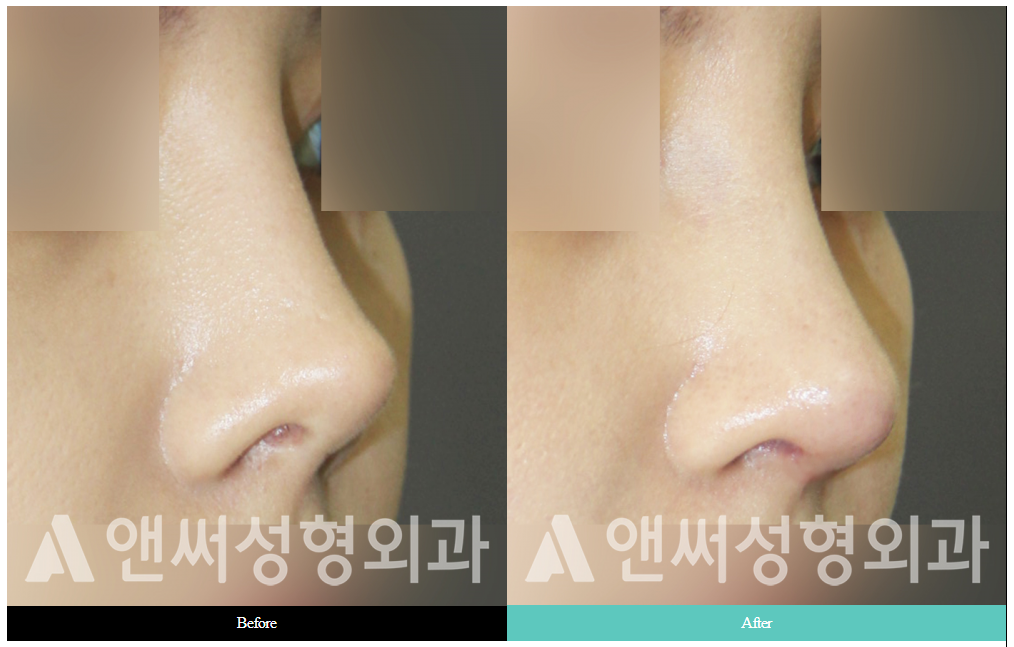
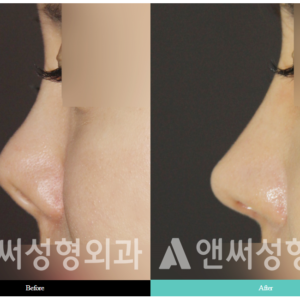
Non-Incisional Rhinoplasty
A non-incisional rhinoplasty provides a non-invasive nose surgery with no visible scars because, as the name says, no incision is made. Another advantage of a non-incisional rhinoplasty is that it causes less swelling and has a relatively short surgery time; thus, the patient can return to their daily activities quickly after a few hours of rest. Although the process seems simple, it requires expertise to achieve optimal outcomes. Sometimes, non-incisional rhinoplasty is confused with closed rhinoplasty. They have similarities as both methods are done inside the nostrils preventing incision scars from showing after surgery. However, unlike closed rhinoplasty, non-incisional rhinoplasty can be performed on deformed noses, such as bent, hooked, and bulging noses.
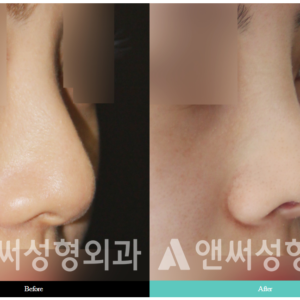
Rhinoplasty General Surgery Details

Answer’s Rhinoplasty Before & After
At Answer Plastic Surgery, Rhinoplasty can be performed using a combination of two cartilages or prostheses to achieve optimal results. We also offer revision rhinoplasty to those who have experienced previously failed nose surgeries.


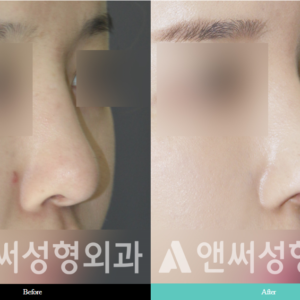

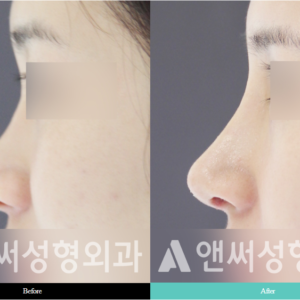

Check out more of Answer Plastic Surgery’s excellent results on our Youtube Channel! Experience the change you deserve. With Answer Plastic Surgery, successful outcomes are guaranteed so you can focus on your recovery.
FAQs
Can a rhinoplasty procedure using ear cartilage successfully correct an upturned nose?
The success of an upturned nose correction depends on how the cartilage is used. Answer Plastic Surgery uses more advanced techniques in using ear cartilage to improve the nasal structure and firmly improve the nasal tip into a more natural look.
Does a nasal septum cartilage rhinoplasty cause a crooked nose?
Although the nasal septum cartilage is the easiest to collect, it can have a higher rate of causing the nasal tip to drop after surgery due to its relatively flat shape making the nose more bent. However, Answer Plastic Surgery initially corrects the bent tissue and then firmly applies the cartilage to give support and avoid further bending that may cause a crooked nose after surgery.
What is the difference between a donated cartilage and an autologous cartilage?
Donated or allogeneic cartilage is taken from other patients or a donor. While autologous (meaning “self”) cartilage is collected from one’s own body and then transplanted into another body part that needs improvement. While donated cartilage can be useful, as the plastic surgeon does not need to collect a patient’s own cartilage, it can, however, easily cause the patient to develop inflammation and further affect the surrounding tissues. These sometimes lead to a reaction or a rejection of an individual’s body to a foreign substance transplanted into it.
On the other hand, autologous cartilage, which is usually used by Answer Plastic Surgery, has minimal risk as there will be no problem of adverse reactions such as inflammation or tissue rejection as it is harvested from the patient’s own body. It also has a low absorption rate, thus resulting in a more natural look.
Among the prostheses and cartilage, which can provide long-lasting support?
The rib costal cartilage provides more extended support because of its durability and robust nasal support. It is also the most abundant cartilage found in the body; hence there will be minimal issues when the plastic surgeon needs to collect more of the material.
Is it possible to use implants in a non-incisional rhinoplasty?
Yes, it is. Although the area of surgery is narrow, it will be a bit difficult, but a beautifully shaped nose can still be created. This can be done by finely trimming the implant into an appropriate size and length to perfectly fit it to form a new improved nose shape.
Does a non-incisional rhinoplasty cause less swelling than an open procedure?
Yes, since it does not involve incisions, it causes minimal side effects. Compared to open rhinoplasty, the non-incisional approach uses non-invasive techniques in a narrow surgery area. Thus, post-operative swelling and bruising are minimal, and the patient can return to their daily activities after a few hours of rest in the clinic after their surgery.
Contact Us
Booking an appointment with Answer Plastic Surgery is easy, as it only takes a click and a few pieces of information input. Avail of our free online consultation and one of our trained and eloquent staff will cater to your needs and inquiries. Once an appointment has been set and online consultation is on the run, you are ready to take off to South Korea for a life-changing plastic surgery experience for a more natural and youthful appearance!
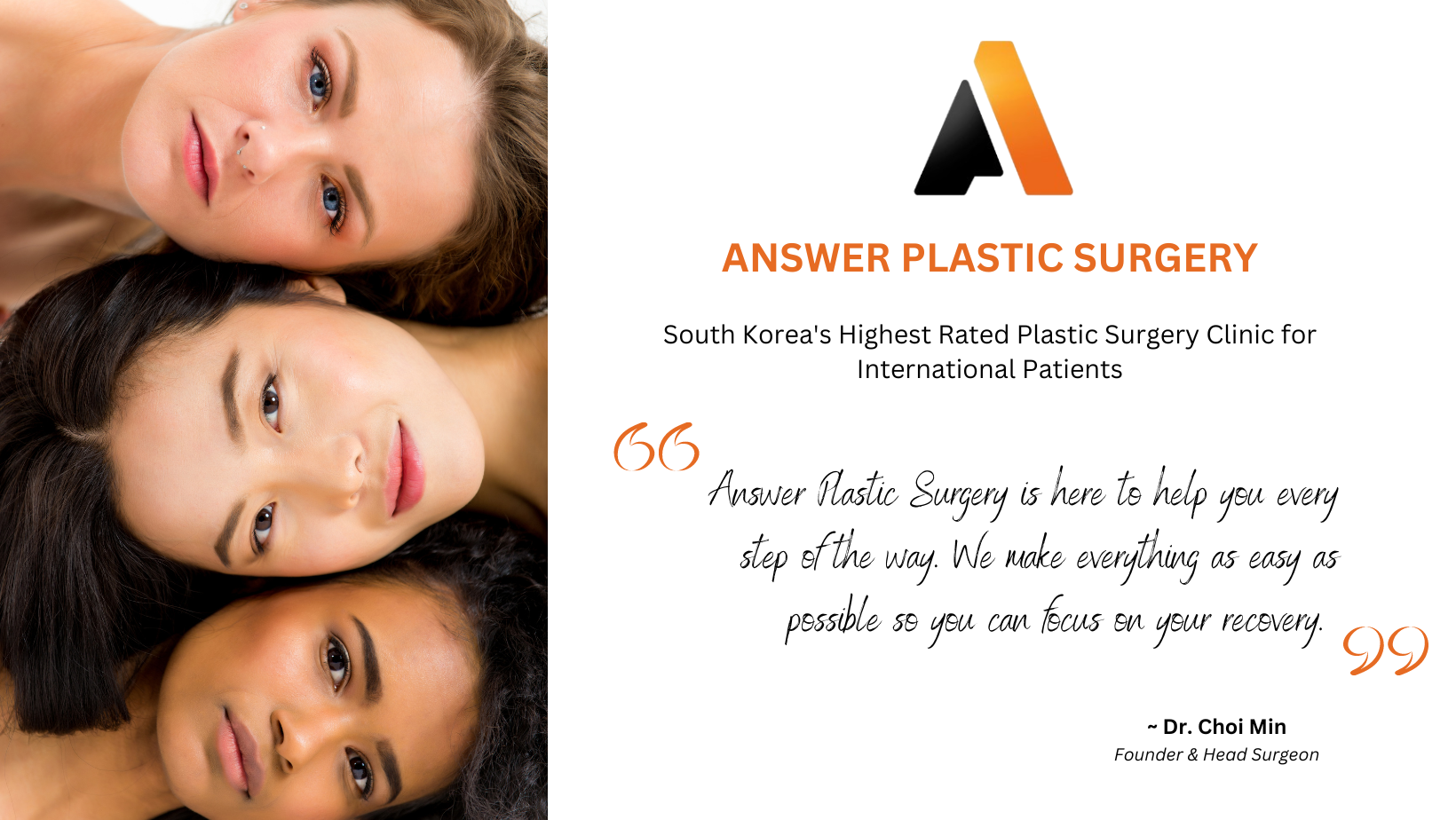
How useful was this post?
Click on a star to rate it!
Average rating 0 / 5. Vote count: 0
No votes so far! Be the first to rate this post.

